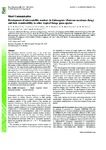Use este identificador para citar ou linkar para este item:
http://www.alice.cnptia.embrapa.br/alice/handle/doc/901385Registro completo de metadados
| Campo DC | Valor | Idioma |
|---|---|---|
| dc.contributor.author | SOUSA, A. C. B. | pt_BR |
| dc.contributor.author | JUNGMANN, L. | pt_BR |
| dc.contributor.author | CAMPOS, T. de | pt_BR |
| dc.contributor.author | SFORÇA, D. A. | pt_BR |
| dc.contributor.author | BOAVENTURA, L. R. | pt_BR |
| dc.contributor.author | SILVA, G. M. B. | pt_BR |
| dc.contributor.author | ZUCCHI, M. I. | pt_BR |
| dc.contributor.author | JANK, L. | pt_BR |
| dc.contributor.author | SOUZA, A. P. | pt_BR |
| dc.date.accessioned | 2011-09-27T11:11:11Z | pt_BR |
| dc.date.available | 2011-09-27T11:11:11Z | pt_BR |
| dc.date.created | 2011-09-27 | pt_BR |
| dc.date.issued | 2011 | pt_BR |
| dc.identifier.citation | Plant Breeding, Boon, v. 130, n. 1, p. 104-108, Feb. 2011. | pt_BR |
| dc.identifier.uri | http://www.alice.cnptia.embrapa.br/alice/handle/doc/901385 | pt_BR |
| dc.description | The Guineagrass (Panicum maximum Jacq.) is one of the most important tropical forage grasses, but genetic knowledge and tools regarding this species are still limited. Therefore, 20 novel polymorphic microsatellite markers were developed, validated, and employed in estimating genetic relationships among 25 P. maximum genotypes selected from a Brazilian germplasm collection. In addition, they were tested for cross-species amplification in four other forage grass species. The number of alleles observed for each locus ranged from 4 to 12 (average 6.7). The values of polymorphism information content (PIC) varied from 0.41 to 0.83 (average 0.61) and the discriminating power (D) ranged from 0.53 to 0.98 (average 0.72). Cross-amplification demonstrated the potential transferability of these microsatellites to four tropical forage grass species. Cluster analysis based on the unweighted pair group method revealed three distinct groups: two clusters consisted of P. maximum genotypes and a third cluster, consisted of the other tropical forage grass species. The data demonstrated that the microsatellites developed herein have potential for germplasm characterization and genetic diversity analysis in P. maximum and other forage grass species. | pt_BR |
| dc.language.iso | eng | eng |
| dc.rights | openAccess | eng |
| dc.subject | Capim Tanzânia | pt_BR |
| dc.subject | Guineagrass | pt_BR |
| dc.subject | Marcador microssatélite | pt_BR |
| dc.subject | Amplificação cruzada | pt_BR |
| dc.subject | Fitomejoramiento | pt_BR |
| dc.subject | Marcadores genéticos | pt_BR |
| dc.subject | Pastos forrajeros | pt_BR |
| dc.subject | Repeticiones de microsatélite | pt_BR |
| dc.subject | Variación genética | pt_BR |
| dc.title | Development of microsatellite markers in Guineagrass (Panicum maximum Jacq.) and their transferability to other tropical forage grass species. | pt_BR |
| dc.type | Artigo de periódico | pt_BR |
| dc.date.updated | 2019-01-09T11:11:11Z | pt_BR |
| dc.subject.thesagro | Melhoramento genético vegetal | pt_BR |
| dc.subject.thesagro | Gramínea forrageira | pt_BR |
| dc.subject.thesagro | Capim Colonião | pt_BR |
| dc.subject.thesagro | Panicum maximum | pt_BR |
| dc.subject.thesagro | Seleção genótipa | pt_BR |
| dc.subject.thesagro | Variação genética | pt_BR |
| dc.subject.thesagro | Marcador genético | pt_BR |
| dc.subject.thesagro | Polimorfismo genético | pt_BR |
| dc.subject.thesagro | Genótipo | pt_BR |
| dc.subject.nalthesaurus | Plant breeding | pt_BR |
| dc.subject.nalthesaurus | Forage grasses | pt_BR |
| dc.subject.nalthesaurus | Megathyrsus maximus | pt_BR |
| dc.subject.nalthesaurus | Genotype | pt_BR |
| dc.subject.nalthesaurus | Genetic variation | pt_BR |
| dc.subject.nalthesaurus | Genetic markers | pt_BR |
| dc.subject.nalthesaurus | Microsatellite repeats | pt_BR |
| dc.subject.nalthesaurus | Genetic polymorphism | pt_BR |
| riaa.ainfo.id | 901385 | pt_BR |
| riaa.ainfo.lastupdate | 2019-01-09 -02:00:00 | pt_BR |
| dc.identifier.doi | 10.1111/j.1439-0523.2010.01779.x | pt_BR |
| dc.contributor.institution | A. C. B. SOUZA, UNIVERSIDADE ESTADUAL DE CAMPINAS | pt_BR |
| dc.contributor.institution | LETICIA JUNGMANN CANCADO, CNPGC | eng |
| dc.contributor.institution | TATIANA DE CAMPOS, CPAF-ACRE | eng |
| dc.contributor.institution | D. A. SFORÇA, UNIVERSIDADE ESTADUAL DE CAMPINAS | eng |
| dc.contributor.institution | L. R. BOAVENTURA, UNIVERSIDADE ESTADUAL DE CAMPINAS | eng |
| dc.contributor.institution | G. M. B. SILVA, UNIVERSIDADE ESTADUAL DE CAMPINAS | eng |
| dc.contributor.institution | M. I. ZUCCHI, UNIVERSIDADE ESTADUAL DE CAMPINAS | eng |
| dc.contributor.institution | LIANA JANK, CNPGC | eng |
| dc.contributor.institution | A. P. SOUZA, UNIVERSIDADE ESTADUAL DE CAMPINAS. | eng |
| Aparece nas coleções: | Artigo em periódico indexado (CPAF-AC)  | |
Arquivos associados a este item:
| Arquivo | Descrição | Tamanho | Formato | |
|---|---|---|---|---|
| 23925.pdf | 238.21 kB | Adobe PDF |  Visualizar/Abrir |









